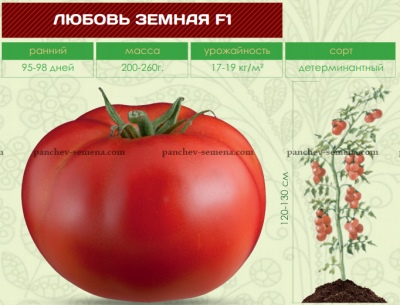
- Authors: Panchev Yu.I.
- Year of approval: 2010
- Category: hybrid
- Growth type: determinant
- Appointment: fresh consumption
- Ripening period: early
- Ripening time, days: 95-98
- Growing conditions: for open ground, for film greenhouses
- Transportability: Yes
- Marketable fruit yield,%: 95%
Lyubov Zemnaya is a tomato variety bred by Russian breeders and approved for use in 2010. Over the years, the variety has gained many fans. Summer residents are attracted by undemanding care and excellent taste characteristics. Suitable for growing beginners.
Description of the variety
The bush is semi-spreading, powerful, it develops up to a height of 120-130 cm. The foliage is pronounced, the leaves are green, of medium size. The inflorescence is simple, the first inflorescence is formed over 5-6 leaves, the subsequent ones - after 1-2 leaves.
The main qualities of the fruit
The unripe tomato has a light green color, the ripe fruit has a red skin. The tomatoes are quite large in size, their weight is 200 g, the shape is round. 5-6 fruits are formed on one brush at once. Tomatoes are characterized by good transportability, the marketable type has 95% of the harvest, and therefore the variety can be grown commercially.
Taste characteristics
Gardeners note the excellent taste of tomatoes. They are mainly used for fresh consumption; the taste is especially pronounced in the vegetable salad. And also such tomatoes are well suited for cooking national dishes, stews and stewing.
Ripening and fruiting
Earthly Love belongs to varieties with an early ripening period. The first tomatoes can be eaten after 95-98 days.
Yield
For one collection, on average, it is possible to collect 28 kg / sq. m. It is recommended to harvest immediately after the tomato is ripe, since the overripe fruit of this variety is considered already spoiled. It is allowed to harvest green unripe fruits that will reach the desired state within a month. Ripe tomatoes are well transported and stored for a long time at a temperature of + 14… 16 degrees.
The timing of planting seedlings and planting in the ground
Sowing is done between late February and mid-March. Planting and leaving is as follows.
Sort out the seeds and disinfect them.
Plant the seeds in a container, 2 cm deep.
Cover the container with foil and take it to a place where the temperature is +25 degrees.
When shoots appear, remove the film and leave the container in a bright place. Daylight hours should be 14-16 hours. The use of phytolamps is recommended.
When 2-3 leaves appear, dive the seedlings.
Feed the young seedlings with Kemira two or three times.
A week before transplanting to the summer cottage, start hardening the shoots. Take the pots outside and increase the time you are outdoors each day.
Plant the seedlings outdoors 60 days after sowing.

Growing tomato seedlings is an extremely important process, because it largely depends on whether the gardener will be able to harvest at all. All aspects must be taken into account, from seedbed preparation to planting in the ground.
Landing scheme
It is undesirable to plant sprouts densely; a distance of 40 cm in a row and 70 cm between rows should be left between the holes. If the soil is dense, it is recommended to add peat and sand - these additives will lighten its structure. Use phosphorus, nitrogen, potassium as soil fertilizer.Do not lower the acidity level if the soil is too acidic - the plant feels comfortable in such conditions.

Growing and care
This variety can be grown both outdoors and in a film greenhouse. For high yields, the culture needs pinching and garter, it is recommended to form a plant in 2 stems.
Once every five days, you need to water the tomatoes with warm, settled water, but it is important not to overdo it with irrigation, and not to overfill the plant. Watering should be done in the evening.
As necessary, the soil is loosened and weeds are removed, usually it is enough to carry out this procedure every 10 days. Four times a season, the crop needs additional feeding; combined formulations including potassium, phosphorus and nitrogen are used as fertilizers.




A plant needs different micronutrients at each stage of growth. All fertilizers can be divided into two groups: mineral and organic. Folk remedies are often used: iodine, yeast, bird droppings, eggshells.
It is important to observe the rate and period of feeding. This also applies to folk remedies and organic fertilizers.
Disease and pest resistance
The presented variety has strong immunity against such ailments as tobacco mosaic virus, alternaria, fusarium, but it can be affected by phomosis ("Hom" can cope with it), black spot ("Fitolavin"), late blight ("Fitosporin").
Of insects, this variety is loved by slugs, aphids, caterpillars of the tomato scoop. In the fight against them, infusions of garlic and celandine, soap or soda solution, as well as the preparations "Profi", "Karate", "Decis" have shown good efficiency.



























































































